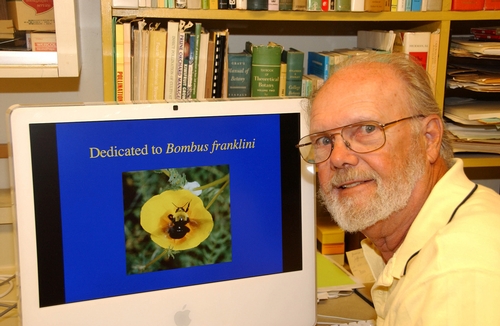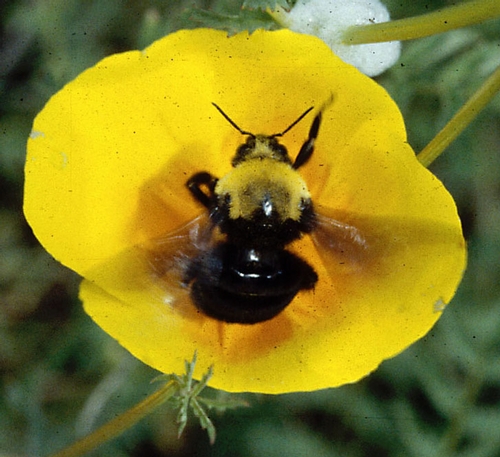That's because it's rarely seen.
Its narrow distribution range covers parts of southern Oregon (Jackson, Douglas and Josephine counties) and northern California (Siskiyou and Trinity counties). That's 190 miles north-south and 70 miles east-west.
"Franklin’s bumble bee has the smallest range of distribution of any of our 60 species of North American bumble bees, and perhaps of the 250 bumble bees in the world,” said noted bumble bee expert and native pollinator specialist Robbin Thorp, emeritus professor of entomology at UC Davis.
Thorp, who has been closely monitoring the Bombus franklini population since 1998, counted 100 that first year. In 2003, he found only three. And since 2006, only one.
Franklin's bumble bee may already be extinct, but he hopes not. Thorp and The Xerces Society for Invertebrate Conservation, headquartered in Portland, Ore., petitioned the U.S. Fish and Wildlife Service on June 23 to place it on the endangered species list.
A decision may be reached within 90 days.
“The decline of Franklin’s bumble bee is a signal that something is wrong in its environment,” said Thorp. “This is the canary-in-the-coal-mine measure.”
He hypothesizes that the key reason for its disappearance may be an exotic disease that spread from commercial bumble bee colonies to wild bumble bee populations.
“People often ask the value of Franklin’s bumble bee," said Thorp, a member of the California Academy of Sciences and The Xerces Society. "In terms of a direct contribution to the grand scale of human economies, perhaps not much, but no one has measured its contribution in those terms. However, in the grand scheme of our planet and its environmental values, I would say it is priceless.”
“Loss of a species, especially a pollinator, diminishes our global environment. Bumble bees provide an important ecological service--pollination. This service is critical to reproduction of a huge diversity of plants that in turn provide shelter, food (seeds, fruits) to diverse wildlife. The potential cascade of effects from the removal of even one localized pollinator may affect us directly and indirectly.”Is it too late to provide protection for a species that may already be extinct?
No, it's not.
“Other species, especially plants and insects, thought to be extinct have reappeared after years of not being seen,” the UC Davis scientist said. “When populations of species are in decline, they may reach such low levels that they are not detected for several years in a row, despite intensive surveys--flying under the radar so to speak. It is my hope that this is the case with Franklin’s bumble bee.”
“One positive sign,” Thorp said, “comes from increasing finds the past two years of a related species, the Western bumble bee, which exhibited similar declines at the same time and places."On his most recent trip, July 21-24, to the narrow distribution range, he didn't find Franklin's bumble bee but he did find the related Western bumble bee at two sites, one individual at each site.
That's a good sign. Perhaps B. franklini will eventually show up as well. Thorp is planning another trip in mid-August and another in early September.
Meanwhile, if the critically imperiled Franklin's bumble is granted protective status, a snowball effect could occur.
This could “stimulate research into the probable causes of its decline,” Thorp said. “This may not only lead to its recovery, but also help us better understand environmental threats to pollinators and how to prevent them in future. This petition also serves as a wake-up call to the importance of pollinators and the need to provide protections from the various threats to the health of their populations.”
More about the mission to Save Franklin's bumble bee
Watch Robbin Thorp's webcast about Franklin's bumble bee
Attached Images:

Robbin Thorp

Franklin's bumble bee